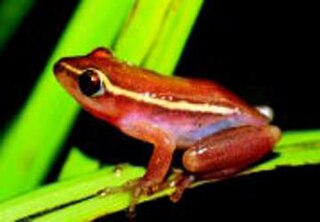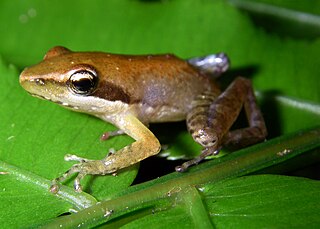Nectophrynoides vestergaardi, also known as the Vestergaard's forest toad, is a species of toad in the family Bufonidae. It is endemic to the West Usambara Mountains, Tanzania. It is named in honour of Martin Vestergaard, the Danish biologist who was the first to recognize that the population now described as Nectophrynoides vestergaardi was a new species.
Vitreorana castroviejoi is a species of frog in the family Centrolenidae. It is endemic to Cerro el Humo in the Paria Peninsula, Sucre state, northern Venezuela. It is locally known as ranita de cristal de Castroviejo. The specific name castroviejoi honors Javier Castroviejo Bolívar, a Spanish zoologist.
Charadrahyla nephila is a species of frog in the family Hylidae. It is endemic to Mexico and occurs in the Sierra de Juárez and Sierra Mixe in the northern Oaxacan highlands; there is also a questionable record from the Sierra de los Tuxtlas, Veracruz. Prior to its description, it was mixed with Hyla chaneque. The specific name nephila is derived from Greek nephos ("cloud") and philia ("fondness"), referring to the cloud forest habitat of this species. Common name Oaxacan cloud-forest treefrog has been coined for it.

Sarcohyla bistincta, also known as the Mexican fringe-limbed treefrog or Cope's streamside treefrog, is a species of frog in the family Hylidae. It is endemic to Mexico; it is widespread and occurs from southern Sinaloa and Durango southeastward to Veracruz and Oaxaca. The nominal Sarcohyla bistincta consists of several lineages that may eventually be described as distinct species.
Hyperolius dintelmanni is a species of frogs in the family Hyperoliidae. It is endemic to Cameroon and found in the montane southwestern part of the country. Specifically, it has been recorded from the Bakossi Mountains, including the Edib Hills and Mount Kupe. The specific name, dintelmanni, honors Mr. Horst Dintelmann from Germany in recognition of "his support of taxonomic research and forthcoming conservation projects in Cameroon".
Hyperolius igbettensis is a species of frog in the family Hyperoliidae. It is found in West Africa from Guinea eastward to Liberia, Ivory Coast, Ghana, Togo and Benin, Nigeria, and into Central Africa at least to Cameroon but likely further east to the Central African Republic and southwestern Chad; the eastern border of distribution of this species relative to other members in the Hyperolius nasutus complex is unclear. Common name Igbetti long reed frog has been coined for it. The type locality is near Igbetti, a village in Oyo State, Nigeria.

Pickersgill's reed frog is a species of frog in the family Hyperoliidae. It is endemic to South Africa. It occurs in the coastal lowlands of KwaZulu-Natal between Sezela and St Lucia.
Leptopelis yaldeni is a species of frog in the family Arthroleptidae. It is endemic to Ethiopia and occurs in the montane highlands in Gojjam. Its range might be limited by the deep gorges of the Blue Nile. It is named in honour of Derek Yalden, a British zoologist who collected some of the types. Common names Yalden's tree frog and grassland forest treefrog have been coined for this species.

Craugastor sabrinus, also known as the long-legged streamfrog, is a species of frog in the family Craugastoridae. It is found in Belize and eastern Guatemala. The specific name sabrinus is derived from the Latin sabrina, meaning "river nymph", and alludes to the stream-side habitat of this species.
Pristimantis ceuthospilus is a species of frogs in the family Craugastoridae. It is endemic to northern Peru and occurs in the western slopes of the Cordillera de Huancabamba and the Pacific slope of the Cordillera Occidental. There are also as yet unconfirmed records from southern Ecuador. The specific name ceuthospilus, from Greek keuthos ("hidden") and spilos ("spot"), refers to the yellow spots in the groin and thighs that remain hidden when the frog is sitting. Common name Wild's robber frog has been coined for it.
Eleutherodactylus corona is a species of frog in the family Eleutherodactylidae. It is endemic to the Massif de la Hotte, Haiti. The specific name corona is derived from the Latin word for "crown" and refers to the distinctive tubercles on the top of the head of these frogs. Common name Caye Paul robber frog has been coined for it.
Pristimantis ortizi is a species of frogs in the family Craugastoridae. As currently known, it is endemic to northern Ecuador where it occurs on the Cordillera Oriental in the Carchi, Imbabura, and Napo Provinces, but it is likely to also occur in adjacent Colombia. The specific name ortizi honors Fernando Ortiz-Crespo, a prominent Ecuadorian ornithologist. Common names Ortiz robber frog and Ortiz's robber frog have been proposed for this species.
Pristimantis variabilis is a species of frog in the family Craugastoridae. It is found in the lowland Amazon rainforest and Andean slopes in southern Colombia, eastern Ecuador, eastern Peru, and western Brazil. The specific name variabilis refers to the variable dorsal coloration of this frog. Common name variable robber frog has been proposed for it.

Fritziana ohausi is a species of frog in the family Hemiphractidae. It is endemic to the mountains of coastal southeastern Brazil in Rio de Janeiro, Espírito Santo, and São Paulo states. The specific name ohausi honors Friedrich Ohaus, a German physicist and herpetologist. Common name Petropolis treefrog has been proposed for this species.

Blommersia blommersae is a species of frog in the family Mantellidae. It is endemic to east-central Madagascar. Both the generic and specific names honour Rose Marie Antoinette Blommers-Schlösser, a Dutch herpetologist and entomologist who collected the type series. Common name Moramanga Madagascar frog has been proposed for it.
Meristogenys poecilus is a species of frog in the family Ranidae. It is endemic to Borneo and known from between central Sarawak (Malaysia) and central Kalimantan (Indonesia). The specific name poecilus is derived from the Greek poikolos, meaning "pied" or "blotched", in reference to diagnostic pattern on rear of the thigh. Common name Malaysian Borneo frog has been coined for this species.
Cornufer mamusiorum is a species of frog in the family Ceratobatrachidae. It is endemic to the central Nakanai Mountains in New Britain, Papua New Guinea. The specific name mamusiorum refers to the Mamusi, a local tribe.
Odorrana utsunomiyaorum is a species of frog in the family Ranidae. It is endemic to Ryukyu Archipelago, Japan, and is known from the islands of Ishigaki and Iriomote, both in the Yaeyama Group. The specific name utsunomiyaorum honours Taeko and Yasuaki Utsunomiya for their contributions to clarifying the amphibian fauna of the Yaeyama Group.
Papurana supragrisea is a species of true frog, family Ranidae. It is endemic to New Guinea, including some nearby islands. It is known with certainty only from southeastern New Guinea and from the D'Entrecasteaux Islands. However, this name has been used more broadly for a species complex that is widely distributed in the mountains of New Guinea. Common name Papua gray frog has been coined for it.
Meristogenys maryatiae, also known as Maryati's torrent frog, is a species of frog in the family Ranidae. It is endemic to the state of Sabah, in the Malaysian part of Borneo. The specific name honours Prof. Datin Mohamed Maryati, entomologist from the Universiti Malaysia Sabah, who helped the describers of this species during their herpetological surveys in Sabah.





